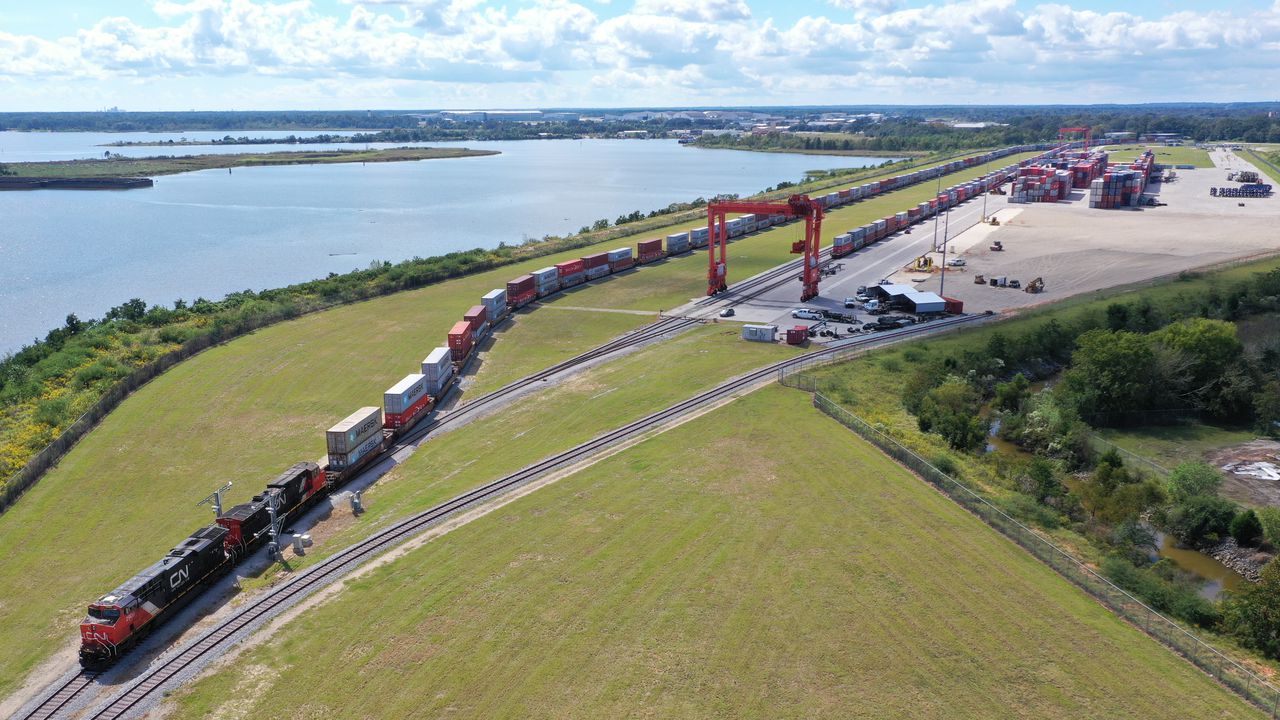$60 million investment to boost Port of Mobile’s container growth
APM Terminals Mobile, which operates the booming container shipping terminal in Mobile, says a $60 million investment will supercharge its ability to transfer cargo from ships to trains over the next two years.
According to an APM Terminals announcement on Tuesday, the company will add more than a mile of track at the Intermodal Container Transfer Facility (ICTF) where shipping containers are loaded on and off of rail cars. The project will more than double the facility’s total length of working track to more than 12,000 feet (about two and a quarter miles). New track, new storage space, additional equipment and improved access will “enhance productivity, safety and supply chain speed,” according to the announcement.
In the big picture, the expansion of the port’s existing ICTF is yet another piece of complex plan to keep the Port of Mobile on a path of rapid growth in container shipping. The port drew in new business amid the supply-chain turmoil of the COVID-19 pandemic, and official want to make sure it can continue to meet those and other growth opportunities.
“Our customers are looking for expanded options for their supply chains so we are focusing on faster connections to rail providers into inland markets,” said Leo Huisman, Head of APM Terminals Americas. “These improvements and our expanded rail facility will ensure customer competitiveness and strengthen Alabama as the preferred logistics corridor,”
“The company’s operational focus is based on vessels which can arrive at any hour and can start port operations immediately,” said Tuesday’s APM announcement.
Related:
Port Authority study: 300,000-plus jobs, $85 billion economic impact
For Port of Mobile, 2022 was another boom year in container shipping
A-USA rail corridor: Alabama’s supply-chain fix has been a long time coming
John Driscoll, director and CEO of the Alabama Port Authority, said the $60 million that APM is putting into the Intermodal facility goes hand-in-hand with $25 million the Port Authority is spending on a new bridge that will connect the container terminal directly to it.
Currently, Driscoll said, containers coming off ships are loaded onto roadgoing trucks, which use some public streets, notably Baker Street, to get from the container terminal to the ICTF. There they may be stockpiled before a second move takes them into position to be loaded aboard train cars.
When the bridge is built, trucks will have a direct path that keeps them off public streets and potentially eliminates the need for that extra transfer. “It’s going to improve the efficiency fairly dramatically,” Driscoll said. APM’s investment includes additional container-handling equipment as well to increase the capacity and speed of the ICTF, he said.
Mobile’s container terminal set a new record in 2022, handing more than half a million standard container shipping units (TEUs) of cargo for the second time in its history and beating 2021′s benchmark by more than 11%. The next phase in an ongoing expansion campaign will bring its annual capacity to over one million TEUs by 2025.
The improved rail connections are one piece of a larger effort. The U.S. Army Corps of Engineers is midway through a project to deepen the Mobile Ship Channel, allowing bigger ships to reach the container terminal’s four giant cranes – which are to be joined by two more that have been ordered by APM. Meanwhile, projects are under way to open up container shipping on two rail corridors that connect the port to inland Alabama markets. One will provide a direct connection to an inland port facility that the Port Authority is building in Montgomery; the other will serve the Birmingham region and points north.
There are a lot of moving parts in the campaign to develop the port and each of them is a huge, multimillion-dollar project. But on a basic level, much of it comes down to anticipating where bottlenecks might develop as the port grows and eliminating them preemptively.
APM Terminals’ new investment is “really just consistent with that vision,” Driscoll said.
The ICTF sits on about 90 acres of land, he said. “When we built it out for that first phase, it was maybe a quarter to a third built out,” he said. “This is not doing the full build-out. I would estimate that this is maybe doubling the capacity … so we have some additional room to grow.”
“They’re obviously anticipating, thinking ahead, with the growth expected to continue,” Driscoll said. “We’re trying to stay ahead of the curve.”
Driscoll revealed that another big step in that effort is already in the design phase. The container terminal currently can handle two 1,000-foot-long ships at a time. An expansion of the wharf that will allow the container terminal to handle three ships at a time is in the works. Driscoll said he thinks the project will be completed in the next three to four years, and the additional capacity will be essential in five to seven years.
“It’s not if, it’s when,” he said.
